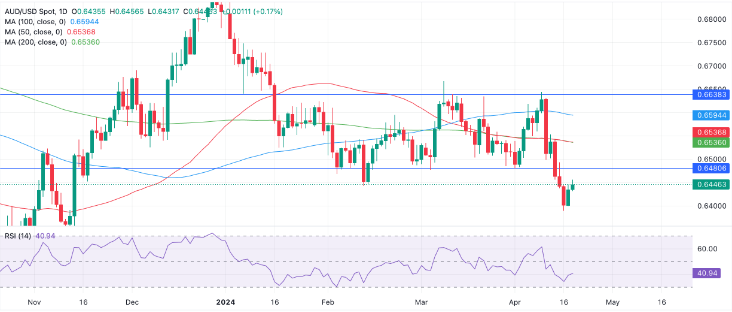- AUD/USD sees a modest recovery following the recent sharp decline.
- Both the Fed and RBA are anticipated to postpone interest rate cuts at present.
- Consequently, the interest rate differential, a significant FX driver, is unlikely to expand as significantly as in other currency pairs.
On Thursday, AUD/USD edges up by approximately 0.1% to reach the 0.6440s, extending the correction from the significant sell-off experienced in early April.
The chart below illustrates a prevailing bearish sentiment in price movements, particularly evident after hitting a new year-to-date low of 0.6389 on Tuesday.
AUD/USD Daily Chart

The recent downturn in AUD/USD, starting from April 10, was triggered by a sudden strengthening of the US Dollar (USD). Strong macroeconomic indicators from the US, alongside a robust labor market and persistent inflationary pressures, have compelled the US Federal Reserve (Fed) to postpone its plans for interest rate cuts. This anticipation of prolonged higher interest rates in the US, aimed at tempering economic growth, has bolstered the US Dollar, attracting increased foreign capital inflows.
While the sell-off in AUD/USD was less pronounced compared to other Dollar pairs, this is partly attributed to Australia’s persistent inflationary pressures, which have led to expectations that the Reserve Bank of Australia (RBA) will also delay interest rate cuts. Unlike the Fed, the RBA had shown less inclination towards rate cuts earlier in the year.
In Australia, this delay suggests that the RBA is now not anticipated to lower the 4.35% overnight cash rate until November 2024. According to Westpac, markets currently anticipate the RBA to keep the cash rate unchanged at the upcoming May 7 meeting, with a 60% probability of a cut by November.
There has been a notable shift in market expectations regarding the number of rate cuts the RBA is expected to implement in 2024, reflecting a similar trend seen with the Fed. BBH notes that the market now prices in a 90% probability of a 25 basis point rate cut in 2024, compared to nearly 50 basis points of total easing anticipated earlier in the month.
Despite significant macroeconomic data releases from Australia, such as the Australian Bureau of Statistics Labour Force Survey (LFS), which indicated a decrease in employment by 6.6k and a slight increase in the Unemployment Rate to 3.8%, the data failed to significantly influence the movement of the Aussie Dollar. According to Westpac, while the rise in the Unemployment Rate remains below the RBA’s estimated full employment range of 4.0% – 5.75%, it is unlikely to prompt immediate policy adjustments, thus having minimal impact on the Australian Dollar.
